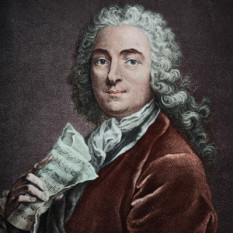Carl Friedrich Abel (1723–1787) was a German composer. He was a fine player on the viola da gamba, and composed important music for that instrument.
Abel was born on 22nd December 1723 in Cöthen, the son of Christian Ferdinand Abel, the principal viola da gamba and cello player in the court orchestra of Johann Sebastian Bach. On Bach's recommendation, in 1748 he was able to join Johann Adolph Hasse's court orchestra at Dresden where he remained for ten years. In 1759 he went to England, and became chamber-musician to Queen Charlotte. He gave a concert of his own compositions in London, performing on various instruments, one of which, the pentachord, was newly invented.
In 1762, Johann Christian Bach, the eleventh son of Johann Sebastian Bach, joined him in London, and the friendship between him and Abel led, in 1764 or 1765, to the establishment of the famous Bach-Abel concerts, England's first subscription concerts ever. In those concerts, many famous guest artists appeared, and the works of Haydn received their first English performance.
For ten years the concerts were organised by Mrs Teresa Cornelys, a retired Venetian opera singer who owned a concert hall at Carlisle house Soho Square, then the height of fashionable events. In 1775 the concerts became independent of her, to be continued by Abel unsuccessfully until a year after Bach's death in 1782. After the failure of his concert undertakings Abel still remained in great request as a player on various instruments new and old, but he took to drink and thereby hastened his death, which occurred in London on 20th June 1787.
One of the most widely known of his works became famous due to a misattribution: in the nineteenth century, a manuscript symphony in the hand of Wolfgang Amadeus Mozart, was catalogued as his Symphony no 3 in E flat, K. 18, and was published as such in the first complete edition of Mozart's works by Breitkopf & Härtel. Later, it was discovered that this symphony was actually the work of Abel, copied by the young Mozart - evidently for study purposes - while he was visiting London in 1764. That symphony was originally published as the concluding work in Abel's Six Symphonies, op. 7. .
You can find information through the best music search engine - Muzlan.top 😊All materials on request "Carl Friedrich Abel" are available on page Carl Friedrich Abel
Yes of course. You can listen tracks on the page Carl Friedrich Abel
Yes of course. You can download tracks on the page Carl Friedrich Abel
This page is found by queries: Carl Friedrich Abel song download, Carl Friedrich Abel mp3 download, Carl Friedrich Abel all mp3, Carl Friedrich Abel free download, Carl Friedrich Abel remix

